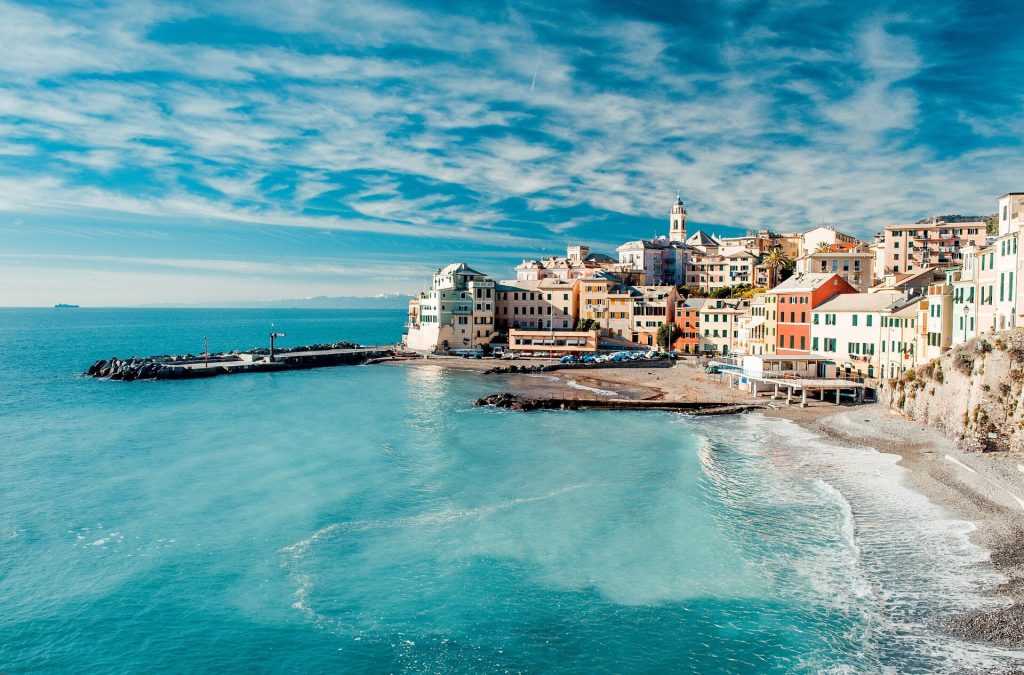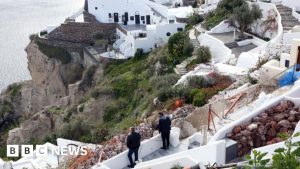
An accumulation of weak to moderate earthquakes has been recorded around the Greek island of Santorini since 24 January. The seismic activity is concentrated in the area between the islands of Santorini and Amorgos, with a center around 25 km northeast of Santorini.
The GEOMAR Helmholtz Centre for Ocean Research Kiel and the GFZ Helmholtz Centre for Geosciences Potsdam classify the current events in these questions and answers.
What is the cause of the many earthquakes near the volcanic island of Santorini?
Between Santorini, the underwater volcano Kolumbo, and Amorgos, many earthquakes between 4 and 10 kilometers deep have been occurring for more than ten days. The magnitude of the quakes has so far reached magnitude 5 or just above. The activity started with weak quakes under Santorini and has been moving northeastwards in recent days along a crustal zone of weakness running from southwest to northeast.
Such earthquake swarms are not uncommon under active volcanic systems and have also been observed repeatedly under Santorini and Kolumbo (Bohnhoff et al. 2006). One possible cause is volcanic activity, i.e. molten rock or other fluids rising upwards in the earth’s crust. Another possibility is the movement of the earth’s plates, which can lead to stresses in the rock and the sudden release of these stresses and thus to earthquakes.
A combination is also conceivable: Individual segments of the Aegean tectonic plate in the region around Santorini move away from each other by a few millimeters. This leads to a stretching and thinning of the earth’s crust, similar to pulling a tough dough apart, which then becomes thinner in the center. Where the crust stretches, fluids and magmas can rise.
Can these earthquakes be predicted?
It is not possible to predict when such an earthquake swarm will occur. There are precursor phenomena, especially in volcanic earthquake swarms. We are currently investigating the temporal development and accompanying changes in the earthquake swarm, such as uplift or subsidence.
Can a volcanic eruption be predicted?
A volcanic eruption cannot be predicted either. However, unlike earthquakes, volcanic eruptions often have clear precursor phenomena. These include ground heave and swarm earthquakes, which intensify before an eruption and move towards the earth’s surface or seabed. So far, there is not enough data to warn of an imminent eruption. Nevertheless, the warnings to avoid cliffs, for example, are correct and important.
What could happen in the event of an eruption or a major earthquake like the one in 1956?
In July 1956, two earthquakes with magnitudes of over 7 occurred in the now seismically active region. One of them occurred in the upper earth’s crust and caused a local tsunami with wave heights of up to 22 meters on the island of Amorgos. The quakes caused extensive damage in the region. Fifty people died. In the current earthquake series, we are seeing much weaker quakes. The rupture zone of 1956 has not yet accumulated enough energy again due to the low displacement rates, but movements in other previously inactive rupture zones cannot be ruled out.
If an earthquake comparable to that of 1956 or a volcanic eruption (the last major eruption of the Kolumbo volcano occurred in 1650) were to occur today, stronger effects could be expected due to the denser population. Strong ground shaking could damage or cause buildings to collapse, especially older buildings or those that were not constructed to be earthquake-proof. Tsunamis could hit coastal regions and lead to flooding, not only on Santorini, but also on neighboring islands and the Greek mainland. Submarine landslides of the caldera could also occur. However, the probability of this is still low.
Discover the latest in science, tech, and space with over 100,000 subscribers who rely on Phys.org for daily insights.
Sign up for our free newsletter and get updates on breakthroughs,
innovations, and research that matter—daily or weekly.
Is a volcanic eruption on Santorini imminent?
The area directly below the Santorini volcano is currently seismically calm. The last time there was similar seismic activity there was in 2011, with very shallow quakes at a depth of 1 to 2 kilometers. However, there was no eruption.
What is the risk of a tsunami there?
There are more tsunamis in the Mediterranean than in other regions of the world. Around 80% of tsunamis are caused by strong earthquakes that raise or lower the seabed—tsunamis can also occur in the Mediterranean due to tectonic conditions.
A volcanic eruption in the region, such as the Santorini volcano, could also trigger a tsunami—whether through undersea explosions or landslides under water.
Volcanic processes can also cause landslides on land or under water. This could displace large masses of water and trigger tsunamis. The Greek authorities and international researchers are monitoring the situation very closely. We cannot rule out the possibility of a tsunami or a major earthquake.
How can such vulnerable regions be monitored?
Thanks to modern monitoring systems, seismic activity and volcanic processes can now be easily observed. The Greek Seismological Service operates a dense monitoring network in the region that also records small earthquakes. GEOMAR, GFZ and other partners have launched a rapid response mission as part of the MULTIMAREX project. Together with our Greek partners (Laboratory of Physical Geography, University of Athens), we are on site to install additional measuring instruments on the seabed and in the Santorini caldera and to monitor seismic activity.
The aim of the monitoring is to precisely record and quantify the number, location and strength of the earthquakes. In the coming days, we will be able to recognize whether the recently observed increase in magnitude and intensity of the earthquake sequence is continuing or subsiding.
What measures are necessary to protect the population?
As long as earthquake activity continues, there is an increased risk of landslides, particularly on steep coastal sections. People should therefore avoid beaches and cliffs. Very strong earthquakes—significantly more intense than those recorded so far—could also trigger tsunami waves. There are currently no measurements that indicate earthquakes of this magnitude.
The Greek authorities send warnings in several languages with rules of behavior and protective measures directly to mobile devices via cell broadcast. To do this, the receipt of emergency notifications must be activated.
Provided by
Helmholtz Association of German Research Centres
Citation:
Q&A: What to know about the earthquakes near Santorini (2025, February 6)
retrieved 6 February 2025
from https://phys.org/news/2025-02-qa-earthquakes-santorini.html
This document is subject to copyright. Apart from any fair dealing for the purpose of private study or research, no
part may be reproduced without the written permission. The content is provided for information purposes only.








